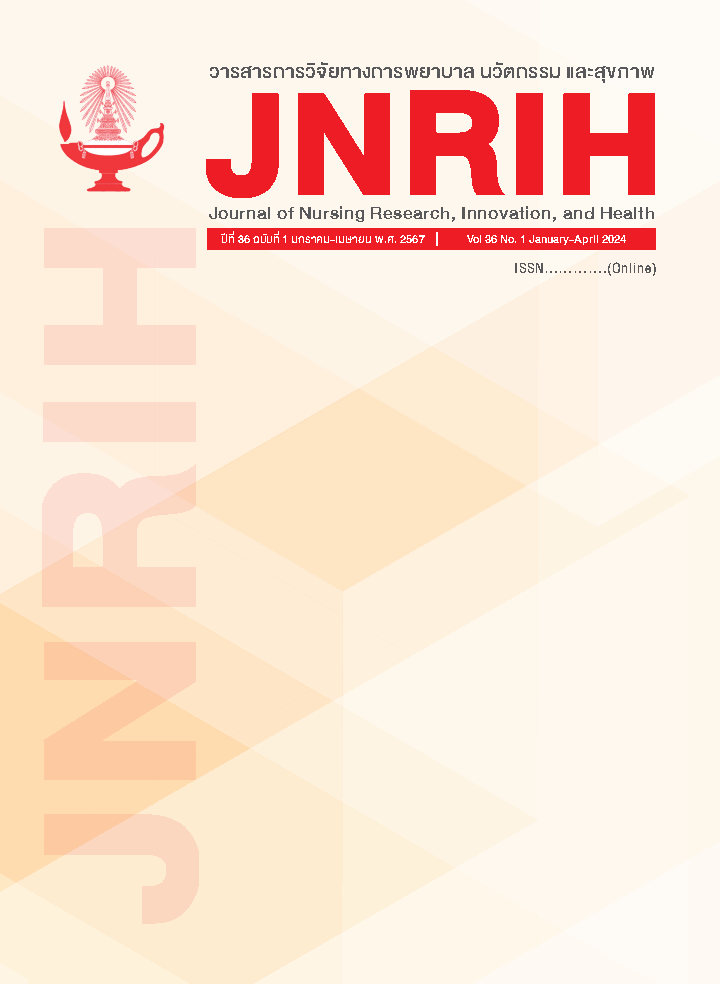Predictive Factors of Delirium in Older Persons at Emergency Department.
Keywords:
delirium, emergency department, older personsAbstract
Purpose: to study predictive factors related to delirium in older persons at emergency department
Design: Prospective descriptive predictive research
Methods: Data were collected from 220 older persons. Who were according to the specified qualifications. Research instruments were demographic questionnaires, 4 A’s Test for Delirium Screening: 4AT, Informant Questionnaire on Cognitive Decline in the Elderly, IQCODE, Numeric rating scale: NRS. And Pain assessment in advanced dementia, PAINAD. Which were tested for reliability. Cronbach’s alpha coefficient was .83, .79 respectively. test-retest procedure reliability was .77, .97 respectively. Data were analyzed using binary logistic regression.
Results: The finding revealed that 1) delirium in older persons at emergency department are 34 people from the total sample size of 220 people. Representing 15.45 percent 2) Cognitive impairment, history of stroke, emergency department length of stay, pain, intracranial hemorrhage, and depression were significantly positive correlated with delirium in older persons at emergency department at level of .05 (x2= 9.277, 10.020, rpb= .216, x2= 9.000, 9.568, 3.874 respectively) 3) Cognitive impairment (AOR=7.25, 95% CI : 1.681-31.276), History of stroke (AOR=4.74, 95% CI : 1.540-14.579), emergency department Length of stay (AOR=6.67, 95% CI : 2.300-19.337), intracranial hemorrhage (AOR=14.72, 95% CI : 2.637-82.151), and depression (AOR=6.96, 95% CI : 1.274-37.998) were significantly factors predicting delirium in older persons at emergency department at the level of .05 and accounted for 37 percent (Nagelkerke R2 = .370, p < .05).
Conclusion: result finding can serve as guidelines for developing programs for nursing care, monitoring, and prevention of the risk of acute confusion in the elderly who receive services in emergency departments.
References
Wilson JE, Mart MF, Cunningham C, Shehabi Y, Girard TD, MacLullich AM, et al. Delirium. Nat Rev Dis Primers. 2020; 6(1):90.
Caplan GA, Kurrle SE, Cumming A. Appropriate care for older people with cognitive impairment in hospital. Med J Australia. 2016;205(S10):S12-S5.
Kespichayawattana J, Suvinee Wivatvanit S. Elderly care in the emergency department. J Nursing Science Chulalongkorn University. 2011:23(2): 1-12.
Oliveirae J. e Silva L, Berning MJ, Stanich JA, Gerberi DJ, Murad MH, Han JH, et al. Risk factors for delirium in older adults in the emergency department: a systematic review and meta-analysis. Ann Emerg Med. 2021;78(4):549-65.
Sri-on J, Tirrell GP, Vanichkulbodee A, Niruntarai S, Liu SW. The prevalence, risk factors and short-term outcomes of delirium in Thai elderly emergency department patients. Emerg Med J. 2016;33(1):17-22.
Morley C, Unwin M, Peterson GM, Stankovich J, Kinsman L. Emergency department crowding: a systematic review of causes, consequences and solutions. PloS One. 2018;13(8):e0203316.
Tran NN, Hoang TPN, Ho TKT. Diagnosis and risk factors for delirium in elderly patients in the emergency rooms and intensive care unit of the national geriatric hospital emergency department: A cross-sectional observational study. Int J Gen Med. 2021;14:6505-15.
Kennedy M, Enander RA, Tadiri SP, Wolfe RE, Shapiro NI, Marcantonio ER. Delirium risk prediction, healthcare use and mortality of elderly adults in the emergency department. J Am Geriatr Soc. 2014;62(3):462-9.
Émond M, Grenier D, Morin J, Eagles D, Boucher V, Le Sage N, et al. Emergency department stay associated delirium in older patients. Can Geriatr J. 2017;20(1):10-4.
Bujang MA, Sa’at N, Bakar TMITA, Joo LC. Sample size guidelines for logistic regression from observational studies with large population: emphasis on the accuracy between statistics and parameters based on real life clinical data. MJMS. 2018;25(4):122-30.
Kuladee S, Prachason T. Development and validation of the Thai version of the 4 ‘A’s Test for delirium screening in hospitalized elderly patients with acute medical illnesses. Neuropsychiatr Dis Treat. 2016;12:437-43.
Siri, S., Okanurak, K., Chansirikanjana, S., Kitiyaporn, D., & Jorm, A.F. (2006). Modified informant questionnaire on cognitive decline in the elderly (IQCODE) as a screening test for dementia for Thai elderly. Southeast Asian J Trop Med Public Health. 2006;37(3),587-594.
Royal College of Anesthesiologists of Thailand, and the Pain Education Association of Thailand.Guidelines for developing acute pain relief after surgery, 2nd edition. 2019. Bangkok: Royal College of Anesthesiologists of Thailand.
Boonsawat N, Suraarunsumrit P, Mandee S, Pitiyan S, Pengsorn N, Srinonprasert V, et al. Reliability “and Validity Study of the Thai version of the Pain Assessment in Advanced Dementia” (PAINAD-Th). Int Psychogeriatr. 2020;32(S1):188.
Bo M, Bonetto M, Bottignole G, Porrino P, Coppo E, Tibaldi M, et al. Length of stay in the emergency department and occurrence of delirium in older medical patients. J Am Geriatr Soc. 2016;64(5): 1114-9.
Inouye SK. Delirium in older persons. NEJM. 2006;354(11):1157-65.
Zipser CM, Deuel J, Ernst J, Schubert M, von Känel R, Böttger S. The predisposing and precipitating risk factors for delirium in neurosurgery: a prospective cohort study of 949 patients. Acta Neurochir. 2019;161(7):1307-15.
Falk A, Kåhlin J, Nymark C, Hultgren R, Stenman M. Depression as a predictor of postoperative delirium after cardiac surgery: a systematic review and meta-analysis. Interact Cardiovasc Thorac Surg. 2021;32(3):371-9.
Lumyong T. Selected factors related to acute Confusion states in mechanically ventilated patients admitted to intensive care units [Thesis]. Bangkok: Chulalongkorn University; 2011. 100 p. (In Thai)
Downloads
Published
Issue
Section
License
Copyright (c) 2024 Journal of Nursing Science Chulalongkorn University

This work is licensed under a Creative Commons Attribution-NonCommercial-NoDerivatives 4.0 International License.
ลิขสิทธิ์ของบทความที่ตีพิมพ์เป็นของวารสารพยาบาลศาสตร์ จุฬาลงกรณ์มหาวิทยาลัย ทั้งฉบับตีพิมพ์เป็นรูปเล่มและเอกสารออนไลน์



